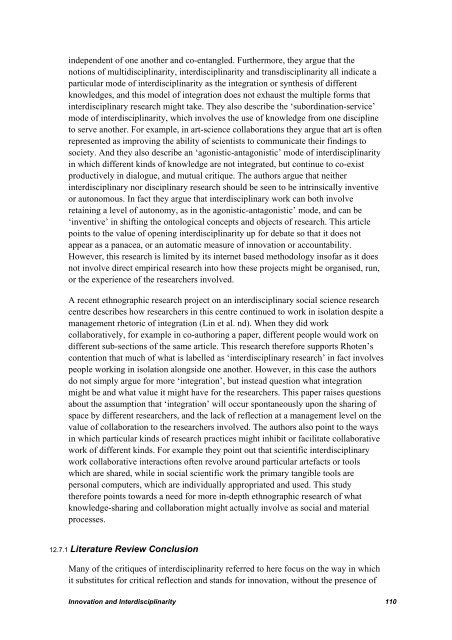Radical innovation: crossing knowledge boundaries with ...
Radical innovation: crossing knowledge boundaries with ...
Radical innovation: crossing knowledge boundaries with ...
You also want an ePaper? Increase the reach of your titles
YUMPU automatically turns print PDFs into web optimized ePapers that Google loves.
independent of one another and co-entangled. Furthermore, they argue that the<br />
notions of multidisciplinarity, interdisciplinarity and transdisciplinarity all indicate a<br />
particular mode of interdisciplinarity as the integration or synthesis of different<br />
<strong>knowledge</strong>s, and this model of integration does not exhaust the multiple forms that<br />
interdisciplinary research might take. They also describe the ‘subordination-service’<br />
mode of interdisciplinarity, which involves the use of <strong>knowledge</strong> from one discipline<br />
to serve another. For example, in art-science collaborations they argue that art is often<br />
represented as improving the ability of scientists to communicate their findings to<br />
society. And they also describe an ‘agonistic-antagonistic’ mode of interdisciplinarity<br />
in which different kinds of <strong>knowledge</strong> are not integrated, but continue to co-exist<br />
productively in dialogue, and mutual critique. The authors argue that neither<br />
interdisciplinary nor disciplinary research should be seen to be intrinsically inventive<br />
or autonomous. In fact they argue that interdisciplinary work can both involve<br />
retaining a level of autonomy, as in the agonistic-antagonistic’ mode, and can be<br />
‘inventive’ in shifting the ontological concepts and objects of research. This article<br />
points to the value of opening interdisciplinarity up for debate so that it does not<br />
appear as a panacea, or an automatic measure of <strong>innovation</strong> or accountability.<br />
However, this research is limited by its internet based methodology insofar as it does<br />
not involve direct empirical research into how these projects might be organised, run,<br />
or the experience of the researchers involved.<br />
A recent ethnographic research project on an interdisciplinary social science research<br />
centre describes how researchers in this centre continued to work in isolation despite a<br />
management rhetoric of integration (Lin et al. nd). When they did work<br />
collaboratively, for example in co-authoring a paper, different people would work on<br />
different sub-sections of the same article. This research therefore supports Rhoten’s<br />
contention that much of what is labelled as ‘interdisciplinary research’ in fact involves<br />
people working in isolation alongside one another. However, in this case the authors<br />
do not simply argue for more ‘integration’, but instead question what integration<br />
might be and what value it might have for the researchers. This paper raises questions<br />
about the assumption that ‘integration’ will occur spontaneously upon the sharing of<br />
space by different researchers, and the lack of reflection at a management level on the<br />
value of collaboration to the researchers involved. The authors also point to the ways<br />
in which particular kinds of research practices might inhibit or facilitate collaborative<br />
work of different kinds. For example they point out that scientific interdisciplinary<br />
work collaborative interactions often revolve around particular artefacts or tools<br />
which are shared, while in social scientific work the primary tangible tools are<br />
personal computers, which are individually appropriated and used. This study<br />
therefore points towards a need for more in-depth ethnographic research of what<br />
<strong>knowledge</strong>-sharing and collaboration might actually involve as social and material<br />
processes.<br />
12.7.1 Literature Review Conclusion<br />
Many of the critiques of interdisciplinarity referred to here focus on the way in which<br />
it substitutes for critical reflection and stands for <strong>innovation</strong>, <strong>with</strong>out the presence of<br />
Innovation and Interdisciplinarity 110

















